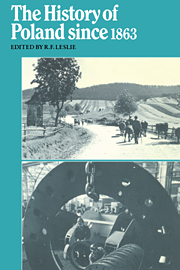Book contents
- Frontmatter
- Contents
- List of maps
- Preface to the paperback edition
- Abbreviations
- Map 1 Poland in the nineteenth century
- 1 Triloyalism and the national revival
- 2 Poland and the crisis of 1900–7
- 3 Poland on the eve of the First World War
- 4 The emergence of an independent Polish state
- 5 The breakdown of parliamentary government
- 6 Piłsudski in power, 1926–35
- 7 Poland without Piłsudski
- 8 Poland in defeat, September 1939–July 1941
- 9 The ill-fated alliance, August 1941–April 1943
- 10 The years of Tempest, May 1943–December 1944
- 11 Post-war Poland
- 12 The rise and ebb of stalinism
- 13 The October turning point
- 14 ‘The little stabilization’
- 15 The decline of Gomułka
- 16 Poland under Gierek
- 17 Polish society, 1945–75
- Epilogue: The rise and fall of Solidarity
- Notes
- Select bibliography
- Index
1 - Triloyalism and the national revival
Published online by Cambridge University Press: 26 December 2009
- Frontmatter
- Contents
- List of maps
- Preface to the paperback edition
- Abbreviations
- Map 1 Poland in the nineteenth century
- 1 Triloyalism and the national revival
- 2 Poland and the crisis of 1900–7
- 3 Poland on the eve of the First World War
- 4 The emergence of an independent Polish state
- 5 The breakdown of parliamentary government
- 6 Piłsudski in power, 1926–35
- 7 Poland without Piłsudski
- 8 Poland in defeat, September 1939–July 1941
- 9 The ill-fated alliance, August 1941–April 1943
- 10 The years of Tempest, May 1943–December 1944
- 11 Post-war Poland
- 12 The rise and ebb of stalinism
- 13 The October turning point
- 14 ‘The little stabilization’
- 15 The decline of Gomułka
- 16 Poland under Gierek
- 17 Polish society, 1945–75
- Epilogue: The rise and fall of Solidarity
- Notes
- Select bibliography
- Index
Summary
Poland in the 1860's
The Poland of today owes its frontiers to the discussions between the leaders of the USSR, Great Britain and the United States of America. The shape of the new state was proposed at Tehran in 1943 by Winston Churchill in order to bring an end to the long conflict between Russia and Poland:
It was agreed in the principle that the hearth of the Polish state and people must be situated between the so-called Curzon line and the line of the Oder River, including Eastern Prussia and the Oppeln Province as part of Poland. But the final drawing of the boundary requires thorough study and possible resettlement in some points.
Stalin modified this proposal in order to assign to the Soviet Union the ports of Konigsberg and Memel. At Potsdam in 1945 the three powers decided that the western frontier should await the final peace settlement:
The three heads of government agree that, pending the final determination of Poland's western frontier, the former German territories east of a line running from the Baltic Sea immediately west of Swinemünde and thence along the Oder River to the confluence of the Western Neisse River to the Czechoslovak frontier … shall be under the administration of the Polish state …
The new Poland differed substantially from the Polish Commonwealth as it stood before the First Partition of 1772, and from the Polish Republic on the eve of the Second World War in 1939. In compensation for loss of territory to the Soviet Union, Poland took possession of substantial German territories in the west. The irony of the present solution is that it was brought about by diplomacy.
- Type
- Chapter
- Information
- The History of Poland Since 1863 , pp. 1 - 64Publisher: Cambridge University PressPrint publication year: 1980



